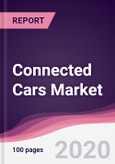Connected Cars Market Outlook:
Some countries spend 3% of their GDP towards road accidents and approximately 1.35 million road traffic accidents are converted into fatalities, according to WHO. As an effective tool for road safety and emergency communication equipped with dedicated short-range communications (DSRC) radios, GPS, 4G LTE, Wi-Fi, Hotspots and cloud services , opportunities in the connected cars market is progressing with a global compound annual growth rate (CAGR) of 17.55% during the forecast period of 2020-2025.
Connected cars is an evolving universal sensation, and North America being a technology-innovating advanced settlement with economies such as the United Sates equipped with cutting-edge and compatible transit infrastructure, embraces the top rank in terms of global connected cars demand with 23.08 % share in 2020. Prevailing advanced traffic management and mobility management infrastructure, offers a compatibility for the adaption and viable commercialization of sophisticated connected cars market in North America. Intelligent Transportation Society of America, is an organization constantly functioning towards renovation of technology for United States transportation services by deployment of technology such as V2V (vehicle to vehicle) and V2I (vehicle to infrastructure) communication, consequently creating abundant demand driving the market. The pioneer of connected vehicles and high-end automobile manufacturer General Motors Co. also has its headquarter in the United States developing an upper hand for the region for sheer affluence in connected cars market.
Compound connectivity solutions assimilated into connected cars necessitate an internet service to accomplish their respective functions. Connectivity can be provided in a car by using embedded, integrated, or tethered connectivity solutions. After analyzing the application modules, integrated connectivity solutions is estimated to be robust growing segment with an application CAGR of 18.23% going through 2025.
Connected Cars Market Trends and Growth Drivers:
- ‘Connected Roads’ is a major trend disrupting the voluminous uptake of connected cars. Smart roads will enable cars to communicate via V2X platform (vehicles to everything), with traffic lights, signals and emergency services centers. Integrated with machine-to-machine (M2M) connectivity platform and telematics, it can transmit real-time updates to motorist regarding traffic hurdles and in case of road hazards to emergency services. To adapt with such next-gen technology, regular automotive market finds an impeccable substitute in connected cars.
- Integration between augmented reality, artificial intelligence and ADAS (advance driver-assistance system) is uplifting the potential of connected cars towards autonomous vehicles. For establishing sustainable market, connected cars manufacturers are moving beyond simple internet connectivity. Startups and automakers are incorporating computer vision and augmented reality (AR) apparatuses into the dashboard to enhance a supplementary layer of safety and personalization to the driving experience.
- One of the most progressive solutions, known as the integrated vehicle health management (IVHM) from Honeywell Transportation Systems, utilizes algorithms derived from data by connected automotive already in service along with highly sensitive sensors to display predictive maintenance requirements, such as tire pressure, fluids, timing, and efficiency. IVHM forestalls glitches before they befall to better inform motorist via connectivity devices for maintenance, reducing the cost of avoidable maintenances.
- Security breaches pertaining to internet connectivity which was a major challenge for the connected cars manufacturers is being sidelined by developing cybersecurity technologies consisting of intrusion detection and protection software. Such assurance in term of security diminishing hacking and system failure has elevated the consumer’s preference towards connected cars positively influencing the market.
Connected Cars Market Players Perspective:
Some of the major players operating in the global connected cars market are General Motors Co., Bavarian Motor Works (BMW) AG, Audi AG, Honda Motor Co. Ltd, Fiat Chrysler Automobiles, Mercedes-Benz, and Continental (Germany), Delphi (UK), Bosch (Germany), Denso (Japan), and Harman (US).
In 2020, General Motors and Enterprise Holdings Partners including, National Car Rental, Enterprise Rent-A-Car and Alamo Rent A Car went under a contract where GM will support Enterprise in adding more than 100,000 connected cars to the rental car company’s convoy over the next 1 year.
Connected Cars Market Research Scope:
The base year of the study is 2020, with forecast done up to 2025. The study presents a thorough analysis of the competitive landscape, taking into account the market shares of the leading companies. It also provides information on unit shipments. These provide the key market participants with the necessary business intelligence and help them understand the future of the connected cars market. The assessment includes the forecast, an overview of the competitive structure, the market shares of the competitors, as well as the market trends, market demands, market drivers, market challenges, and product analysis. The market drivers and restraints have been assessed to fathom their impact over the forecast period. This report further identifies the key opportunities for growth while also detailing the key challenges and possible threats. The key areas of focus include the various types of innovations in connected cars market, and their specific advantages.
The Connected Cars Market report also analyzes the major geographic regions for the market as well as the major countries for the market in these regions.
The regions and countries covered in the study include:
- North America: The U.S., Canada, Mexico
- South America: Brazil, Venezuela, Argentina, Ecuador, Peru, Colombia, Costa Rica
- Europe: The U.K., Germany, Italy, France, The Netherlands, Belgium, Spain, Denmark
- APAC: China, Japan, Australia, South Korea, India, Taiwan, Malaysia, Hong Kong
- Middle East and Africa: Israel, South Africa, Saudi Arabia
Table of Contents
Methodology

LOADING...








